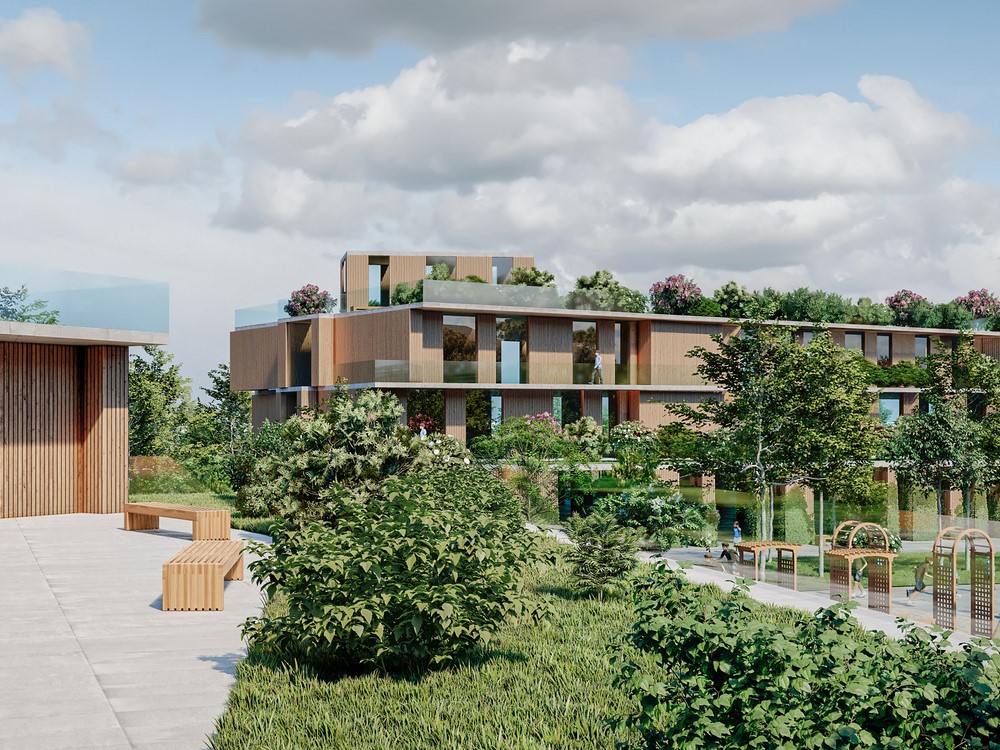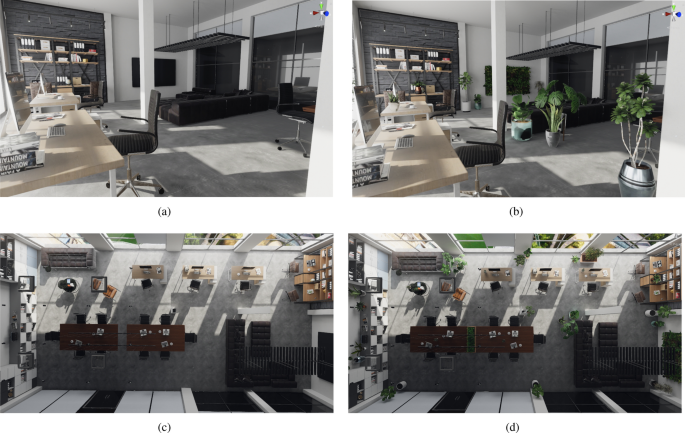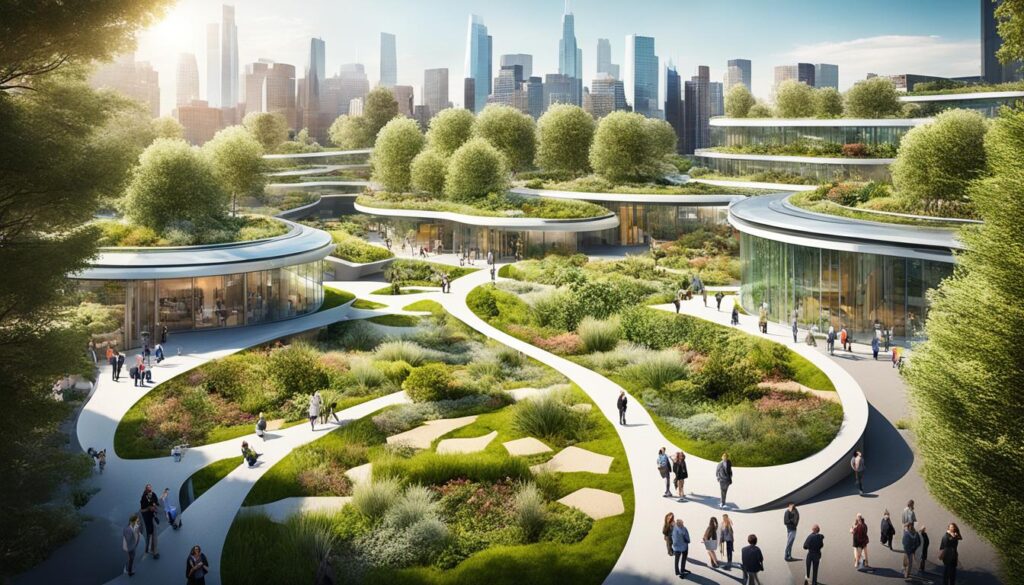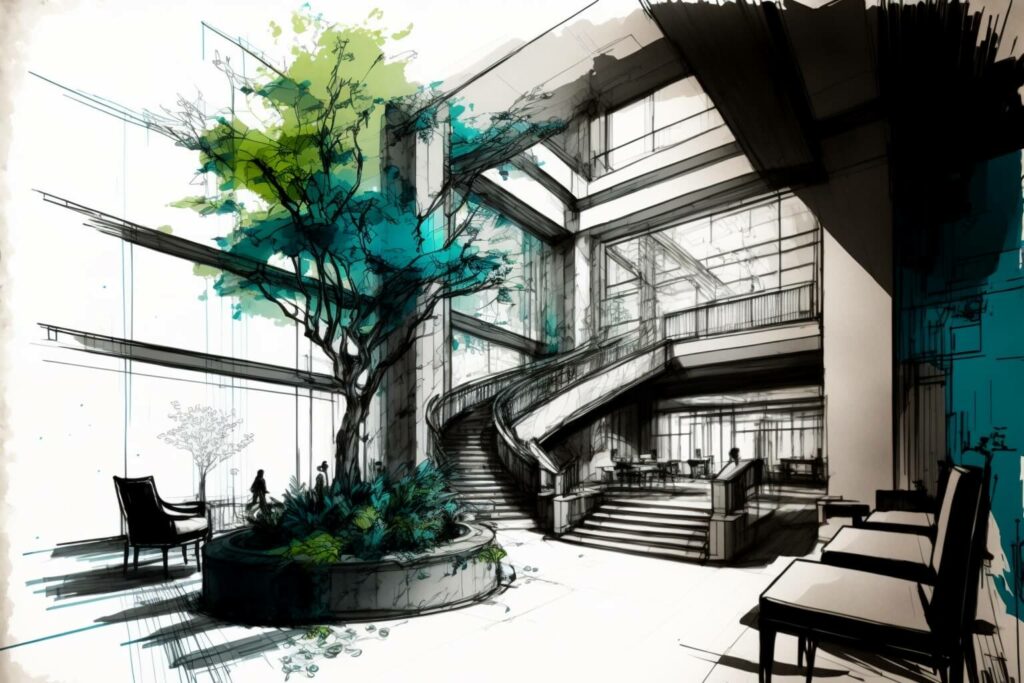Smart Glass and Its Use in Biophilic Architecture.
Smart glass is transforming the field of architecture, particularly in the context of biophilic architecture, which emphasizes the importance of our connection to nature and integrates principles of environmental psychology.
This innovative technology encompasses various types, including electrochromic, thermochromic, and photochromic glass, all of which are engineered to enhance natural light, improve energy efficiency, and provide UV protection.
This discussion will delve into the benefits, applications, and challenges associated with smart glass in biophilic architecture, illustrating how it can convert spaces into harmonious environments that promote well-being, sustainability, and the integration of natural elements.
The exploration will also highlight its future potential in shaping architectural practices through design optimization and performance metrics.
What are the Types of Smart Glass?
.jpg_00.jpeg)
Smart glass signifies a significant advancement in glazing technology, presenting various types that improve energy efficiency, user comfort, and aesthetic appeal in contemporary architecture, contributing to building performance and sustainable practices.
By employing mechanisms such as electrochromic, thermochromic, suspended particle device (SPD), polymer dispersed liquid crystal (PDLC), and photochromic technologies, these glass solutions provide unique functionalities that address the requirements of biophilic architecture, sustainable design, ecological impact, and thermal comfort.
Each type serves specific purposes, including: light control, thermal insulation, and user engagement.
- Glare reduction
- Light modulation
- Enhancement of the indoor-outdoor connection
- Promotion of natural light
1. Electrochromic Glass
Electrochromic glass is a sophisticated type of smart glass that adjusts its tint in response to an electrical charge, thereby allowing for precise regulation of light, heat, and visual aesthetics entering a given space.
This innovative material operates by employing a layer of electrochromic substance positioned between conductive glass layers. When an electrical current is applied, the glass is able to darken or lighten, effectively controlling the amount of solar energy that enters the building.
Such control plays a significant role in energy conservation and energy management by diminishing the dependence on artificial heating and cooling systems, which can lead to substantial reductions in utility expenses.
Furthermore, electrochromic glass enhances user comfort, aesthetic appeal, and adaptive features in both residential and commercial settings by mitigating glare and maintaining stable indoor temperatures while optimizing the influx of natural light.
2. Thermochromic Glass
Thermochromic glass is engineered to alter its color in response to temperature fluctuations, thereby effectively managing solar heat gain, enhancing indoor air quality, and promoting thermal comfort.
By adapting to environmental conditions, this innovative material enables buildings to maintain comfortable temperatures while decreasing dependence on artificial cooling systems. As temperatures rise, the glass transitions to a darker tint, reflecting a greater amount of sunlight and minimizing heat accumulation within interior spaces.
This functionality not only enhances energy efficiency but also aligns with the principles of sustainable architecture and ecological architecture, fostering a harmonious relationship between buildings and their natural surroundings. Additionally, occupants benefit from improved visual comfort and reduced glare, ultimately contributing to a more pleasant living and working environment.
3. Suspended Particle Device (SPD) Glass
Suspended Particle Device (SPD) glass employs suspended particles that align when voltage is applied, facilitating dynamic control over light transmission, privacy, and transparency.
This technology not only enhances comfort by significantly reducing glare but also contributes to an aesthetically pleasing environment, improving visual comfort and user interaction. As architects incorporate SPD glass into their designs, they create spaces that adapt to varying lighting conditions while ensuring that occupants remain engaged with their surroundings.
The versatility of SPD glass aligns seamlessly with the broader trend toward smart environments, emphasizing human-centric design principles and the integration of intelligent windows and smart technology. It enables users to manage their visual comfort effectively, thereby enhancing productivity and overall well-being.
This innovation represents a significant shift toward integrating both passive and active design elements, catering to the functionality and sensory experiences of individuals within the space.
4. Polymer Dispersed Liquid Crystal (PDLC) Glass
Polymer Dispersed Liquid Crystal (PDLC) glass possesses unique switchable properties that allow it to transition from opaque to clear with the simple flip of a switch, thereby enhancing user privacy, providing aesthetic versatility, and promoting visual permeability.
This innovative material functions as an effective barrier to unwanted visibility while integrating seamlessly into contemporary architectural designs. Its applications are diverse, ranging from smart conference rooms that require adaptability to residential spaces that emphasize comfort and elegance.
By facilitating effortless transitions between transparency and opacity, PDLC glass enhances immersive experiences in environments such as museums and galleries, where fluidity in display and ergonomic design are essential.
Furthermore, it significantly contributes to improved indoor-outdoor connections by optimizing natural light, reducing glare, and providing superior sound insulation, ultimately creating tranquil environments that promote focus and relaxation.
5. Photochromic Glass
Photochromic glass automatically adjusts its tint in response to ultraviolet (UV) radiation, thereby optimizing natural light exposure, responsive environments, and reducing reliance on artificial lighting.
This innovative technology not only enhances energy efficiency but also contributes to the overall well-being of occupants by creating a dynamic, responsive environment, and wellness-oriented spaces. As natural sunlight permeates a space, it establishes a connection to the outdoors, aligning with the core principles of biophilic architecture.
This seamless integration of natural elements and nature-inspired design within designed spaces can significantly improve mood and productivity while concurrently minimizing glare and eye strain.
By promoting sustainable design practices and green technologies, photochromic glass supports a holistic approach to wellness, fostering healthier living and working environments that prioritize both mental and emotional comfort.
What are the Benefits of Using Smart Glass in Biophilic Architecture?
The integration of smart glass in biophilic architecture offers various benefits, facilitating a harmonious balance between natural elements and built environments and aligning with biophilic principles.
By permitting ample natural light while simultaneously enhancing energy efficiency, user comfort, and adaptive features, smart glass strengthens the vital indoor-outdoor connection that is essential for promoting health, wellness, and well-being.
Furthermore, these advanced glazing solutions play a significant role in improving indoor air quality, fostering user engagement, and supporting design aesthetics in alignment with contemporary architectural trends that prioritize sustainability and environmental health.
1. Natural Light and Views
.jpg_01.jpeg)
One of the primary advantages of utilizing smart glass is its capacity to maximize natural light, provide unobstructed views, and enhance architectural aesthetics, user experience, and landscape integration.
This characteristic plays a vital role in promoting a healthier environment, as exposure to natural light has been demonstrated to improve mood, increase productivity, enhance overall well-being, and offer cognitive benefits. The incorporation of smart glass allows individuals to maintain a connection with the outdoor landscape, fostering a sense of tranquility and reducing stress levels.
By seamlessly integrating indoor spaces with the external environment, smart glass creates an atmosphere where natural elements can flourish, ensuring that occupants benefit from both the visual and psychological advantages associated with sunlight and restorative environments.
Consequently, the adoption of this innovative technology not only enhances design and spatial quality but also fundamentally supports the holistic health of its users.
2. Energy Efficiency
Smart glass significantly enhances a building’s energy efficiency and energy savings by effectively regulating heat gain and loss, thereby contributing to sustainability and reducing dependence on artificial heating and cooling systems.
This advanced technology facilitates dynamic adjustments in response to environmental changes, enabling precise control over the amount of sunlight, heat, and daylighting that penetrates through the glass. Consequently, occupants experience improved comfort levels, while energy costs are reduced.
By integrating smart glass solutions, architects and builders can design structures that not only uphold the principles of sustainable architecture but also reflect a commitment to climate adaptability and green building.
This innovative material is instrumental in achieving energy conservation objectives, promoting the widespread adoption of eco-friendly design practices and energy-efficient buildings that rely less on nonrenewable energy sources.
3. Improved Indoor Air Quality
By facilitating proper ventilation and minimizing the reliance on artificial lighting, smart glass significantly enhances indoor air quality and natural ventilation, thereby promoting a healthier environment.
This innovative technology not only allows for the natural circulation of fresh air but also reduces the accumulation of indoor pollutants that can adversely affect health, supporting environmental sustainability. As sunlight passes through, the glass adjusts its tint and opacity, effectively regulating temperature and thermal insulation, decreasing the dependence on HVAC systems. This dual functionality not only creates a more comfortable atmosphere but also aids in energy conservation and building automation.
As a result, spaces equipped with smart glass provide a more enjoyable experience for occupants while also contributing to broader sustainability initiatives and biophilic architecture, establishing it as a vital component in the enhancement of overall environmental health and sustainable design.
4. Connection to Nature
The implementation of smart glass technology facilitates a robust connection to nature, enabling occupants to experience unobstructed views of the landscape while remaining engaged with their environment through natural light and transparency.
This connection offers significant psychological benefits, as studies in environmental psychology indicate that exposure to natural views can reduce stress and enhance overall well-being. Through the use of smart glass, individuals are afforded the ability to manipulate light levels and regulate their surroundings, thereby positively influencing their mood, productivity, and overall user experience.
The seamless transition between indoor and outdoor experiences fosters a sense of presence and tranquility, which is especially advantageous in urban environments where access to nature may be limited.
Consequently, the integration of this technology not only enhances aesthetic appeal but also markedly improves comfort levels, creating a harmonious living space that nurtures both mental and physical well-being through health and wellness principles.
How is Smart Glass Used in Biophilic Architecture?
Smart glass serves a crucial function in biophilic architecture, effectively integrating with multiple facets of building design to enhance user experience, foster a connection to nature, and support environmental sustainability through architectural innovation.
Its applications encompass dynamic facades that respond to varying light conditions, as well as innovative interior design elements that facilitate natural ventilation and visual comfort, enhancing energy efficiency and daylighting.
Due to its versatility, smart glass emerges as an essential component in the creation of livable spaces that prioritize health, well-being, and environmental harmony, making it a cornerstone of ecological architecture and green building practices.
1. Facades and Windows
In biophilic architecture, smart glass is exceptionally suited for facades and windows, offering significant daylighting advantages along with enhanced visual transparency, all while ensuring energy efficiency and thermal insulation. This innovative material automatically adjusts its tint, responding dynamically to variations in sunlight and temperature throughout the day.
Consequently, occupants are afforded unobstructed views while minimizing glare and heat gain, thereby contributing to a more comfortable indoor environment. The adaptive characteristics of smart glass improve energy performance by decreasing dependence on artificial lighting and mechanical cooling systems.
By optimizing natural light and thermal conditions, architects have the opportunity to create spaces that promote well-being and productivity, while concurrently prioritizing sustainability. Ultimately, the incorporation of smart glass into architectural design fosters user engagement with their surroundings, establishing a more harmonious relationship between the built environment and the natural world.
2. Skylights and Atriums
Skylights and atriums that incorporate smart glass create immersive experiences by allowing an abundance of natural light to permeate interiors, thereby enhancing both aesthetic appeal and user comfort through responsive environments and sensory experiences.
These architectural features not only illuminate spaces but also play a crucial role in wellness design by fostering a connection to the outdoors. The natural light facilitated by smart glass can significantly reduce reliance on artificial lighting, subsequently minimizing energy consumption while promoting mental clarity and positive moods among occupants.
Furthermore, the capacity to control transparency enables users to adjust light levels and privacy, allowing for a tailored environment that aligns with personal preferences. Consequently, smart glass has the potential to transform traditional designs into interactive spaces that invite the beauty of nature indoors while simultaneously supporting emotional and physical well-being through a thoughtful integration of the surrounding environment.
3. Partitions and Doors
.jpg_10.jpeg)
Smart glass partitions and doors can significantly enhance spaces by providing privacy control while preserving natural light and visual engagement. This innovative solution effectively integrates technology and design, enabling users to adapt their environments according to various needs and preferences.
In office settings, for example, smart glass can be configured to facilitate collaborative environments or to create soundproof areas for focused work, thereby enhancing productivity while maintaining an open and airy atmosphere through ergonomic design and acoustic benefits.
Likewise, in residential applications, this glass technology allows homeowners to appreciate the beauty of their outdoor views while ensuring that their private moments are kept undisturbed. The dynamic nature of smart glass fosters a stronger connection between individuals and their environments, ultimately enriching their overall experience.
4. Greenhouses and Conservatories
The application of smart glass in greenhouses and conservatories facilitates precise temperature control, thereby enhancing the growth of indoor plants by optimizing light conditions. This advanced technology not only regulates the influx of sunlight but also minimizes energy consumption, ultimately resulting in a reduced carbon footprint.
By integrating smart glass into horticultural environments, landscape architects can establish settings that promote biodiversity while adhering to sustainable practices. The capability to adjust the transparency of the glass based on varying weather conditions significantly decreases heating and cooling costs, making it an economically viable option for modern horticulture.
These innovations also contribute to overall water conservation, supporting healthier ecosystems and ensuring that plant growth is both efficient and environmentally friendly through climate adaptability and sustainable practices.
5. Interior Design Elements
Incorporating smart glass into interior design elements significantly enhances user comfort and creates environments that adapt to the needs of occupants through ambient intelligence and smart home integration.
This technology facilitates the seamless integration of transparency and opacity, allowing spaces to transform according to lighting conditions or privacy requirements. For example, conference rooms can effortlessly transition from open, collaborative environments to private meeting spaces with a simple touch, thereby fostering increased productivity and comfort.
Similarly, living areas can adjust their luminosity and openness, contributing to a more inviting atmosphere and enhancing spatial quality and user interaction.
The aesthetic appeal of smart glass is evident in its sleek design and its ability to complement a variety of decor styles, making it a preferred choice among designers aiming to elevate the overall ambiance of a space through design optimization and materials science.
What are the Challenges of Using Smart Glass in Biophilic Architecture?
Despite its numerous advantages, the implementation of smart glass in biophilic architecture entails several challenges, including cost, maintenance, and integration with existing building systems in the context of modern architecture and building automation.
While smart glass technologies provide enhanced energy efficiency and user comfort, the initial investment may be considerable, potentially hindering widespread adoption in sustainable design practices, building materials considerations, and innovation in architecture.
Furthermore, the ongoing maintenance requirements and the complexities associated with integrating smart glass with traditional building materials and systems can present significant obstacles for architects and builders, affecting design strategy and performance metrics.
1. Cost
The initial cost associated with the installation of smart glass may present a significant barrier to its adoption within biophilic architecture, often necessitating a considerable investment in comparison to traditional glazing solutions, impacting user-centric architecture and economic considerations.
However, when evaluating the long-term benefits, it becomes evident that the integration of smart glass can yield substantial financial advantages over time. This technology not only enhances occupant comfort and well-being through improved natural light management but also contributes to significant energy savings by decreasing reliance on artificial lighting and minimizing temperature regulation needs.
Building owners should conduct a thorough assessment of the return on investment (ROI) regarding reduced energy expenses and potential tax incentives. As energy costs continue to escalate, the transformative advantages of smart glass could ultimately provide a compelling financial rationale for its initial expenditure.
2. Maintenance and Durability
Maintaining smart glass systems can pose challenges, particularly in ensuring their durability and performance over time, as these systems may necessitate specialized cleaning and care, influencing maintenance and durability.
Regular inspections are essential for the early identification of potential issues, which helps to prevent significant damage and ensures optimal functionality, contributing to longevity and building performance.
The integration of smart glass into building design requires a comprehensive understanding of its unique maintenance requirements, including appropriate sealing and care protocols to enhance longevity. Furthermore, users must remain cognizant of potential repairs that may arise due to environmental factors or general wear and tear.
By prioritizing these maintenance measures, the efficiency of energy consumption and thermal regulation is sustained, ultimately contributing to the overall performance of the building and the comfort of its occupants through adaptive features and sustainable practices.
3. Glare and Privacy Concerns
While smart glass is designed to enhance user comfort, issues related to glare and privacy may arise depending on the specific applications and settings of the glass, affecting design optimization and visual comfort.
These concerns are particularly relevant in environments where it is essential to maintain a balance between natural light and visual privacy, such as in offices, residences, and public spaces. As users increasingly incorporate smart glass into their daily lives, various solutions, including adjustable tinting, responsive technologies, and privacy control systems, are being investigated to effectively address these challenges and enhance user comfort.
Design strategies may involve layered smart glass systems that provide variable opacity, allowing occupants to customize their visibility according to specific needs at different times of the day. By integrating advanced sensor technologies and intelligent windows, the glass can automatically adjust to changing light conditions, thereby minimizing glare while simultaneously ensuring privacy when required, contributing to energy savings and thermal comfort.
4. Integration with Building Systems
.jpg_11.jpeg)
Integrating smart glass with existing building systems presents a complex challenge that necessitates meticulous planning and collaboration among architects, engineers, and contractors, ensuring seamless integration of smart technology for improved building performance and energy efficiency.
To effectively navigate these challenges, innovative strategies such as modular design frameworks and enhanced software tools are being implemented. These approaches facilitate seamless communication among various building elements, optimizing spatial quality and design flexibility inherent in modern architecture.
Additionally, the integration of advanced sensors can optimize energy consumption by automating the tinting process in response to real-time environmental conditions. This not only improves user comfort but also supports sustainability objectives, rendering modern architecture more adaptable to the evolving needs of its occupants, while contributing to sustainable design and energy management.
By utilizing cutting-edge technologies, professionals are discovering new methods to harmonize aesthetic appeal with functional performance while maximizing the overall efficiency of existing systems, aligning with principles of ecological architecture and environmental sustainability.
What is the Future of Smart Glass in Biophilic Architecture?
The future of smart glass in biophilic architecture is highly promising, propelled by continuous advancements in smart technology and an escalating demand for sustainable design solutions, particularly in the context of green building and energy-efficient buildings.
As architects and builders investigate the potential of smart glass to improve energy efficiency, user comfort, and connection to nature, its significance within the field of architecture is poised to expand.
The incorporation of advanced materials and adaptive glazing techniques is expected to yield new applications that redefine the interaction between built environments and their natural surroundings, enhancing visual connection and promoting health and wellness.
As this technology progresses, it is anticipated that smart glass will feature self-tinting capabilities that respond to varying light levels and user preferences, thereby reducing reliance on artificial lighting and improving indoor biodiversity.
Such innovations could also lead to substantial decreases in energy costs and carbon footprints, aligning with global sustainability initiatives. The seamless integration of interior spaces with outdoor environments enhances the indoor-outdoor connection and has the potential to transform workspace designs, promoting mental well-being and productivity.
Ultimately, the discourse surrounding smart glass extends beyond mere aesthetics; it encompasses a comprehensive vision of enhancing environmental quality, incorporating elements of biophilic design, and fostering a deeper connection to nature within urban landscapes.
Frequently Asked Questions
What is smart glass and how is it used in biophilic architecture?
Smart glass, also known as switchable glass, is a type of glass that can change its transparency level at the flick of a switch. In biophilic architecture, smart glass is used to bring more natural light and views of nature into a building, which can have a positive impact on occupants’ well-being.
What are the benefits of using smart glass in biophilic architecture?
Aside from increasing natural light and views of nature, the use of smart glass in biophilic architecture can also help reduce energy costs by minimizing the need for artificial lighting and air conditioning. It also adds an element of flexibility and control for occupants, allowing them to adjust the level of privacy and light in a space.
How does smart glass contribute to the concept of biophilia?
Biophilia is the innate human connection to nature, and incorporating elements of nature into built environments can have a positive impact on mental and physical well-being. Smart glass allows for the integration of natural light and views of nature, creating a more biophilic and human-centric space.
Are there different types of smart glass that can be used in biophilic architecture?
Yes, there are various types of smart glass available, including electrochromic, thermochromic, and suspended particle device (SPD) glass. Each type uses a different technology to control its transparency level, and the choice will depend on the specific needs and goals of the biophilic design.
How does smart glass impact building design and construction?
The use of smart glass in biophilic architecture requires careful planning and coordination during the design and construction process. This includes considerations for the placement and size of windows, as well as the integration of the necessary technology and controls for the smart glass. Collaboration between architects, engineers, and contractors is essential for a successful project.
Can smart glass be used in existing buildings to create a more biophilic environment?
Yes, smart glass can be retrofitted into existing buildings as well. However, it may require more extensive modifications and may not be as effective in creating a truly biophilic space compared to incorporating smart glass into the initial design. It is best to consult with a professional to determine the feasibility and potential impact of using smart glass in an existing building.

I’m Bruno, an architect with a deep passion for Biophilic Design in Urban Architecture. Throughout my career, I’ve focused on integrating natural elements into urban planning, and I created this site to share my insights and foster a deeper understanding of how biophilic principles can significantly enhance urban living. Dedicated to sustainable development, I continually explore innovative design solutions that promote both environmental and human well-being in city landscapes.














Publicar comentário